




During Art Rotterdam 2023, Upstream Gallery proudly presents the group presentation Intangible Touch, with works by Frank Ammerlaan, Marinus Boezem, Kévin Bray, Harm van den Dorpel, Alicia Framis, Noor Nuyten, Tabor Robak and Rafaël Rozendaal. The show explores mankind’s desire to grasp and depict the intangible in a fast moving world.
Through their innovative ways of experimenting with materials and techniques, the participating artists present artworks that take shape through a range of transformations, aiming to understand life, and by extension, our aesthetic appreciation of it. From movement into abstraction, from virtual into physical, finding presence in absence, turning intangible into tangible.

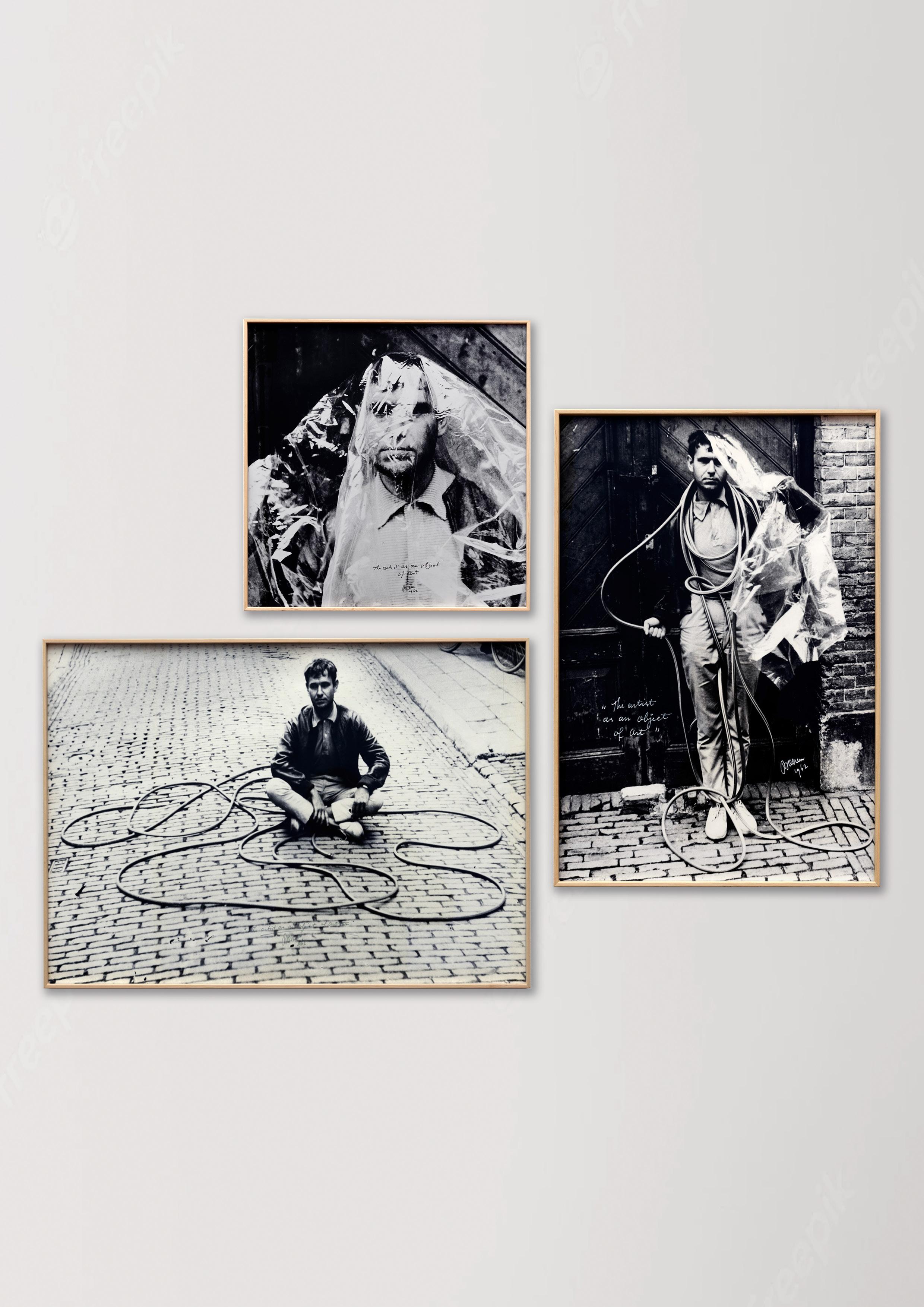
Marinus Boezem (1934, NL) belongs, together with Jan Dibbets and Ger van Elk, among the most important representatives of the Conceptual Art and Arte Povera movement in The Netherlands. In the 1960s, Boezem discovered that he could use elusive elements such as air, weather, wind, and light as visual materials and made a name with radical, immaterial works that were far ahead of their time.
The work The Artist As An Object Of Art (1962) shows the artist Marinus Boezem presenting himself, ironically, as an object of art.
In 1962, Marinus Boezem, with some irony towards being an artist, had his picture taken holding a garden hose and a piece of transparent material as attributes. The photographs were made by Pien Robijns. Three of these recordings remained intact. The first picture is a close-up of the artist’s face and shoulder area, completely enveloped in shiny plastic, through which his face is invisibly hidden. The second photo shows him standing against a gate with a
writhing garden hose draped around him, and the aforementioned crumpled piece of plastic in his hand. The third photo, in which he is sitting cross-legged in the street with the garden hose surrounding him, is a document of an action in Gorinchem that shows the barricading of a street.
The images have the same aura as the Fluxus manifestations that were made at the same period wherein the pictures were taken. The compositions have a parallel with ‘Het eerste (voorlopige) a-dynamische manifest’, signed by Ger van Elk, Wim T. Schippers en Bob Wesdorp (Vrij Nederland, 30 December 1961, p.5), in which personal expression of the artist is looked upon ironically and shapelessness is praised
Marinus BoezemSign the sky above the port of Amsterdam with an aeroplane (1969)
Sign the sky above the port of Amsterdam with an aeroplane, 1969 20 x 75 cm
Framed, unknown edition
 Marinus Boezem
Marinus Boezem
In the work Sign the sky above the port of Amsterdam with an aeroplane (1969) a skywriting airplane writes the word ‘Boezem’ with condensation trails in the cloudy sky above Amsterdam’s harbor. After some time the word begins to vanish and ultimately disappears behind a cloud bank. The happening can be conceived as signing the cosmos, but because the signature is sure to disappear, it appears the artist is distancing himself from this pretentious act. Boezem does not presume to that, and does not confer upon the firmament the aura of an artwork; he is only confirming his discovery in 1963 of air, weather, and wind as visual material. The action is more important than the result. The signature on the heavens is a sign of the expansion of the context of art and a commentary on the rather limited space that is traditionally assigned to artworks.
In the three panoramic photographs, the passage of time between the appearance
and disappearance of the signature remains as a visible souvenir of this airshow. The photographic record, which was created through a process in which time is an important factor, is an essential part of the artwork. The photographs were damaged on June 9, 1993, during a move from Toulon to Paris. The panels were restored in the Ateliers de la Ville de Paris under the responsibility of Anne Cartier-Bresson.
The original photographs can be found in several public collections in the Netherlands and France. This work is an original invitation card from 1969 with reproductions of the original photographs made by Frits Rotgans. At the time, it was used to announce the 6th Paris Biennale (29 September - 2 November 1969) at the Musee d’Art Moderne in Paris, where Signing the Sky Above the Port of Amsterdam with an Aeroplane was on display for the first time. This card has since become a collector’s item.

Rafaël Rozendaal
Extra Nervous 22 08 01 (Desert), 2022
Plexiglass in wooden frame

140 x 94,5 cm
Unique piece
In this last decade, Rafaël Rozendaal (NL, 1980) has made a name with his artworks in the shape of websites, and the way he translates his online work to physical media, like prints, tapestries and installations. With this new line of plexiglass works, Extra Nervous, Rozendaal continues his investigation in the transition from movement into abstraction and from virtual into physical space.
In what can be considered the shortest path from digital to physical, the compositions Rozendaal created are coded to be lasercut by a computer out of mirrored colored plexiglass. They translate an exact, digital line into the physical world, like a mechanical way of drawing. The mirroring colors refer to the experience of color in the digital world: smooth, without texture, seen through the glass of a screen. The reflecting aspect of the artworks adds an extra layer of elusiveness to the tangible translation of the digital.
Through the use of mirrors, there’s also a sense of movement in the works. They deal
with interactivity in the most basic form: the image changes along with the point of view of the observer. Reacting to all kinds of light, the artworks will always live a life outside the control of the artist’s human hand. The reflecting aspect of the artworks adds an extra layer of elusiveness to the tangible translation of the digital.

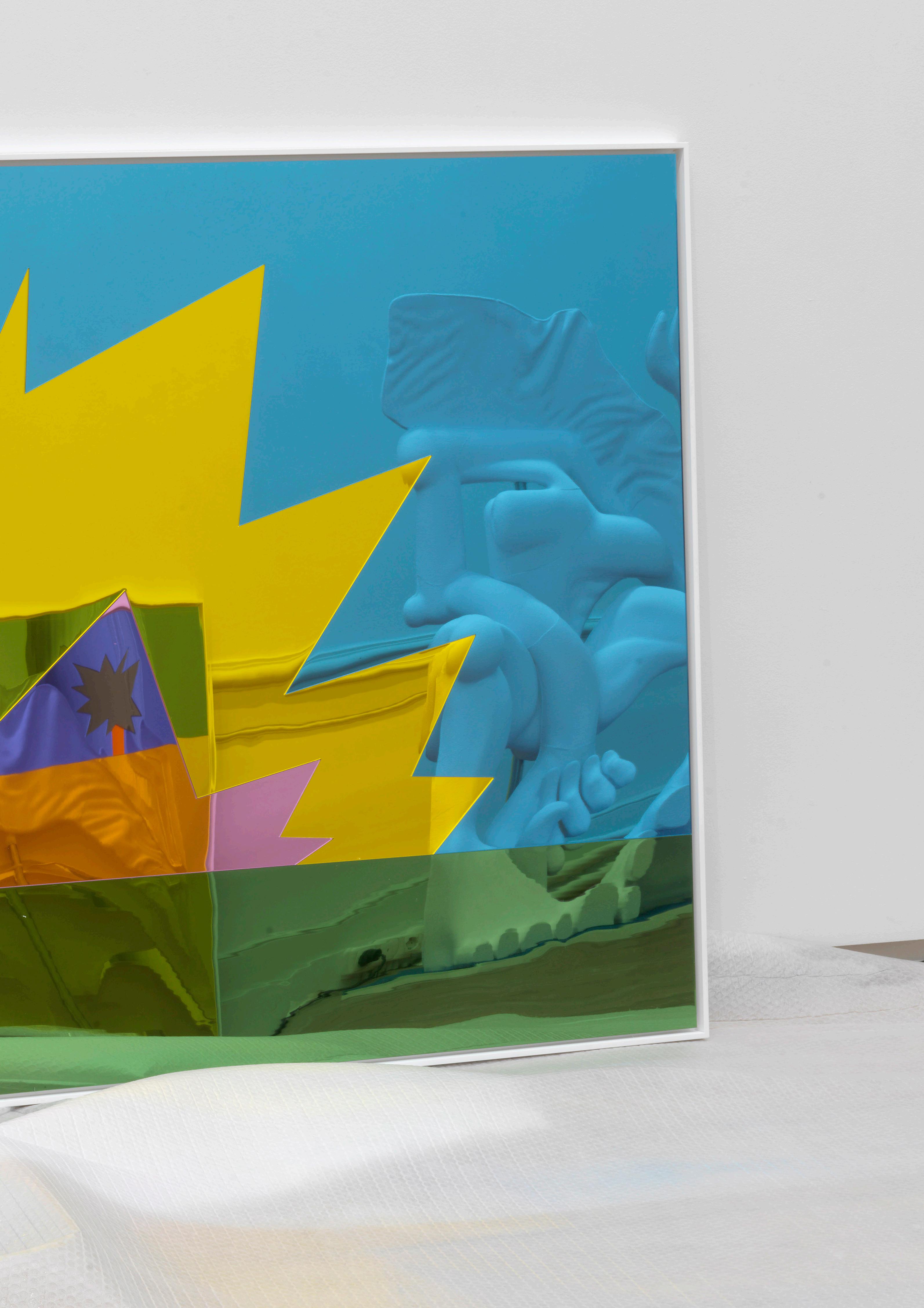 Rafaël Rozendaal Extra Nervous 22 08 02 (Explosion), 2022 Plexiglass in wooden frame 200 x 120 cm
Unique piece
Rafaël Rozendaal Extra Nervous 22 08 02 (Explosion), 2022 Plexiglass in wooden frame 200 x 120 cm
Unique piece
In his work, Frank Ammerlaan (1979, NL) makes use of unconventional materials ranging from dirt and dust to (liquid) metals, chemicals, and meteorite particles. Ammerlaan can be seen as a contemporary alchemist, researching perception, the boundaries of painting, and unpredictable processes.
After years of research in collaboration with scientists and chemists, Ammerlaan permanently captured the fleeting color arrangements of oil spills, which are only visible in the right light on a rainy day, on various canvases. The result is extremely detailed, holographic, and almost seems luminous.
 Framed in high quality wooden frame with museum glass
Framed in high quality wooden frame with museum glass
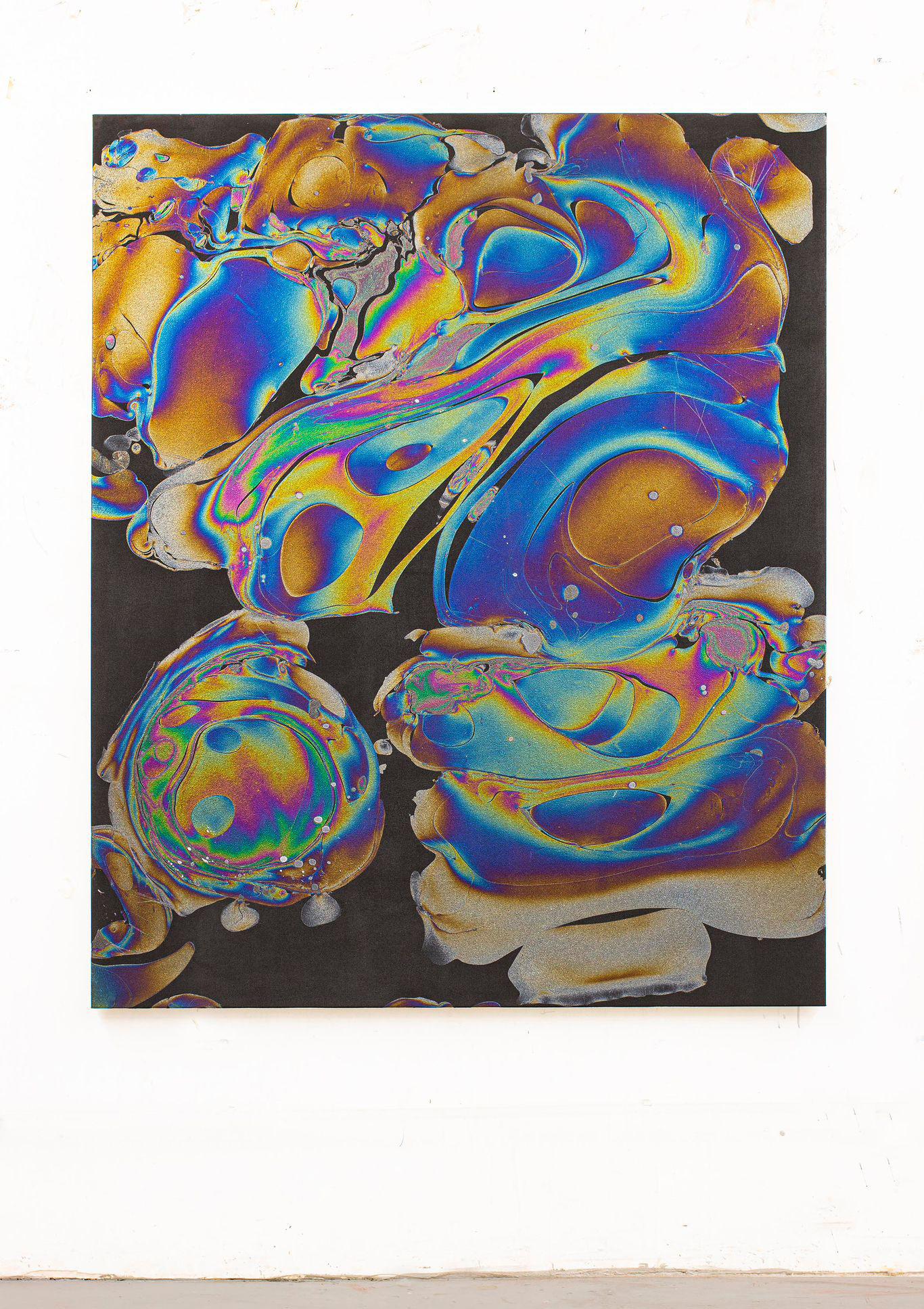 Frank Ammerlaan
Untitled , 2022 Chemicals on canvas
160 x 130 cm Unique piece
Frank Ammerlaan
Untitled , 2022 Chemicals on canvas
160 x 130 cm Unique piece

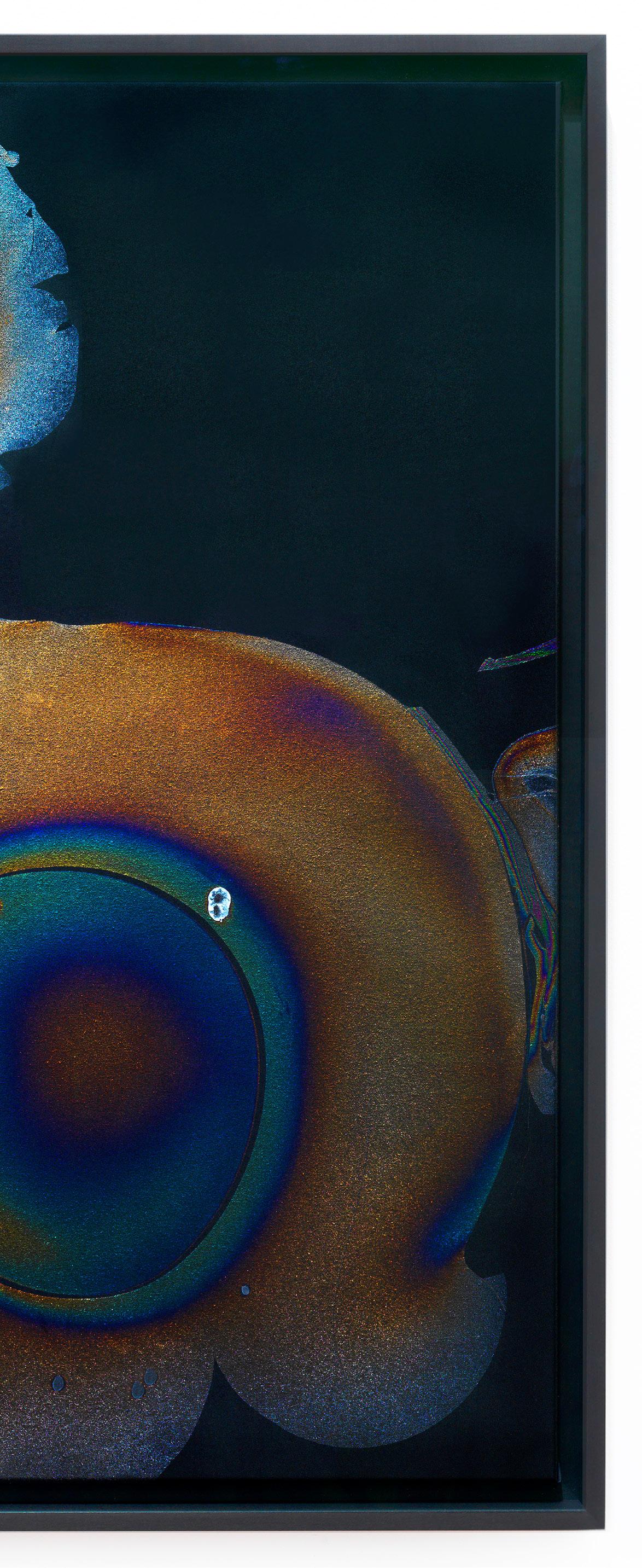

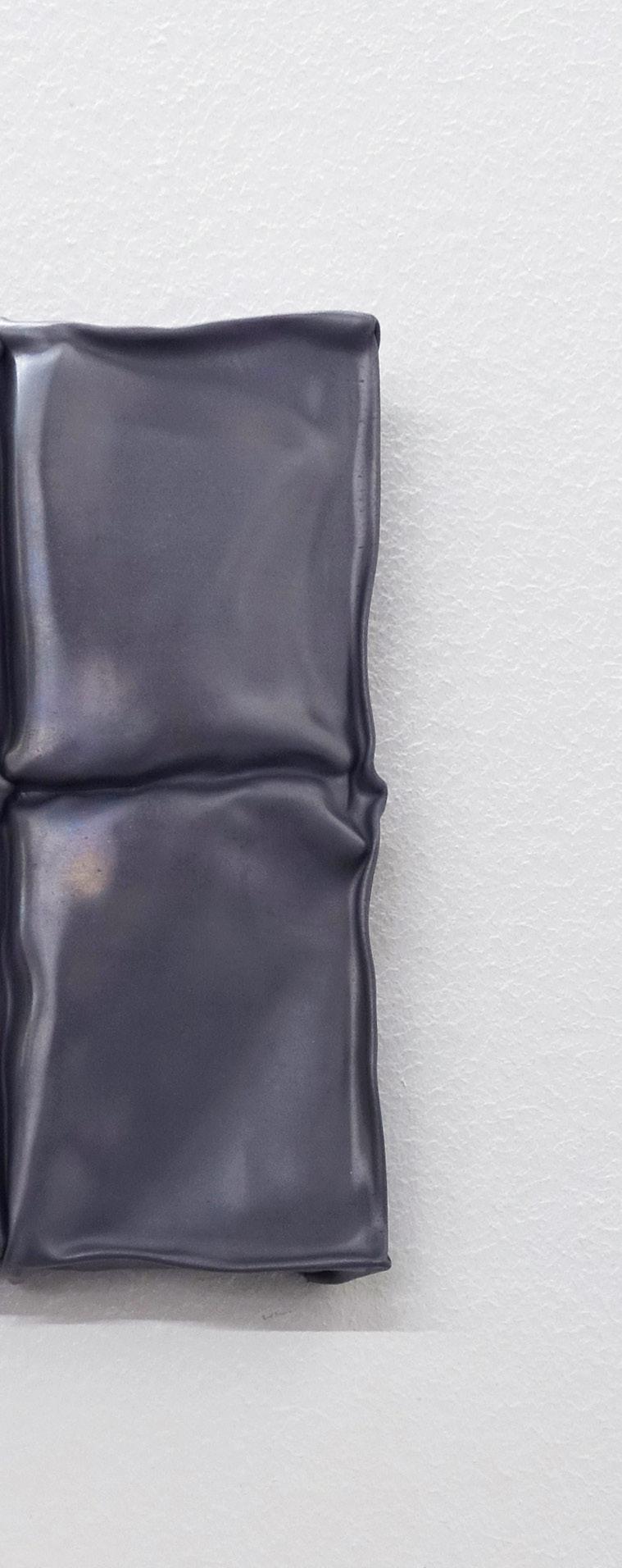
Tabor Robak (1986, USA) work employs computer generated imaging to create videos of invented worlds. Working in programs including Unity, After Effects, Photoshop and Cinema 4D, the artist explores a secondary, digital reality, rendered in what he refers to as a “Photoshop tutorial aesthetic” or a “desktop screensaver aesthetic.” His meticulously produced and filmed environments are cobbled together from sources both sampled and hand-modeled.
In Drinking Bird Universe (2018), Tabor Robak comments on the anxiety induced by the present-day use of smartphones. The work touches upon the around-the-clock newsfeed, consisting of fear-mongering international news and mind-numbing celebrity updates, which stream into the mobile phone. The screen resembles an oversized smartphone that displays live data, including time, date and an RSS feed of the latest news. The video loop is created from a highly detailed fluid simulation, a churning liquid composition of brightly coloured layers. The motion of these layers resembles that of liquid in a jar being constantly shaken, a motion that triggers anxiety and discomfort. The generative artwork shows the fleeting and ephemeral character of current times, wherein overstimulation and uncertainty is omnipresent.
Drinking Bird Universe, 2018
1080P video, brightsign mediaplayer
live date, time, and news feed
Dimensions variable
Duration 30 min. background loop
Edition of 3 plus 2 artist’s proofs (#1/3)
Preview video here
Tabor Robak





Noor Nuyten (1986, NL) creates conceptual works that appeal strongly to the imagination of the viewer. Nuyten is artistically akin to the movement of conceptual artists from the late 1960’s. Meanwhile, her work is undeniably contemporary. Her conceptual works often provide new ways to engage in a critical but humorous relationship with rationally structured systems such as time, language, and units of measurement.
Through the use of screens, place perception is shifting tremendously. Nowadays these digital surfaces even become (virtual) landscapes carried in the hand, created by our own fingerprints. While swiping on a smartphone, a cascade of actions takes place: the touch leaves a pattern of electrodes behind it. Noor Nuyten takes the viewer behind the capacitive touchscreen, recreating the patterns of the electrodes in the series of off-white reliefs called Digital Dust. Transforming an intangible movement into a physical artwork.
After thorough research together with circular company Van Plestik, Nuyten developed a way to 3D print her concept with used electronics, such as computer monitors. These electronics, alluding to the evolution of technology, are shredded, melted and 3D printed. By blending used materials, mundane objects, and gestures, the artist depicts touch on the border of the digital and physical landscape and aims to spark the imagination of the viewer.
 Noor Nuyten
Wi-Fi Off, 2022
Melted and 3d printed (rejected) product of designer Joris Laarman
70 x 89 x 12 cm
Unique piece
Noor Nuyten
Wi-Fi Off, 2022
Melted and 3d printed (rejected) product of designer Joris Laarman
70 x 89 x 12 cm
Unique piece
Noor Nuyten
Enter Passcode , 2022
Melted and 3d printed (rejected) product of designer Joris Laarman

70 x 89 x 12 cm
Unique piece

While scrolling on your smartphone a cosmic ray can strike the Earth’s atmosphere, creating cascades of subatomic particles including energetic neutrons, muons and pions, beating your screen to create a bitflip, manifesting in a glitchy phone.
Without realizing it, you have experienced a cosmic ray attack, creating a bitflip in your smartphone. In the future, cosmic bit flipping will happen more often because processors become smaller and more energy efficient.
For Gazing Bitflips Nuyten started to detect and collect bitflips with a smartphone turned into a pocket detector, discovering lit pixels caused by cosmic rays on a daily basis. It is a first attempt to get bitflips off the screen, by melting and solidifying the exact moment of a cosmic strike on a smartphone. The outcome reminds one of a dazzling galaxy; the home of the cosmic rays.
This new body of work is made of shredded, melted and pressed production waste of Dutch designer Joris Laarman and e-waste, developed in collaboration with Stefania Petroula and circular company van Plestik.
Noor Nuyten
Gazing Bitflips - 14:55, 2022
Shredded, melted and pressed e-waste and production waste of Dutch designer Joris Laarman
90 x 70 cm
Unique piece

Noor Nuyten
CGazing Bitflips - 00:05, 2023
Shredded, melted and pressed e-waste and production waste of Dutch designer Joris Laarman
90 x 70 cm
Unique piece
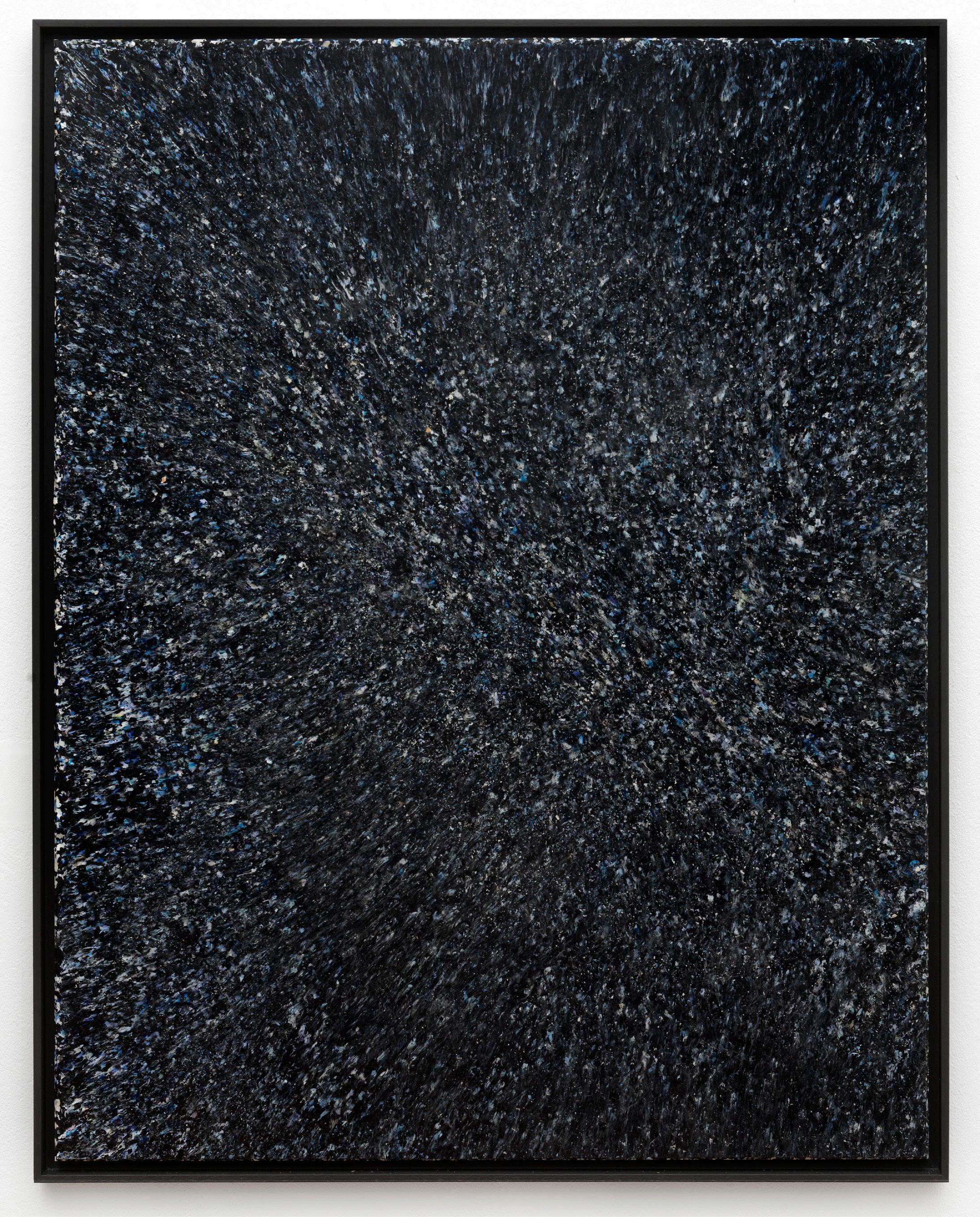
Harm van den Dorpel’s (1981, NL) broad practice includes sculpture, installation, works on paper, computer generated graphics and software. Rooted in the conceptual heritage of net.art, Van den Dorpel’s works often simulate neural networks. The role of technology in his works is a means to an end: a tool to increase the understanding of our experience.
For Harm van den Dorpel the tension between the relative simplicity of computational rules, and the enormous complexity in the outcome, holds the key to understanding life, and by extension, our aesthetic appreciation of it. People are attracted to visual systems which are to some extent complex, novel, and mysterious, yet at the same time contain familiar, repeating elements. Difference and variation, surprise and expectation, have provided essential building blocks in the history of human expression.
The light exposure prints Coralena (Mutation 105) and Coralena (Mutation 62), find their origin in van den Dorpel’s programmed Mutant Garden Software.
With the Mutant Garden software, the artist simulates natural structures that initially seem to be out of our hands and tries to make us connect with them. Clicking one rectangular ‘mutant’ will cause its siblings to be replaced with newly mutated offspring. This breeding strategy requires only one parent to be selected because the algorithm utilizes mutation, rather than cross-over.

Harm van den Dorpel
Coralena (Mutation 105), 2022
Exposure on light sensitive metallic paper, mounted and framed 125 x 110 cm
Edition of 1 plus 1 artist’s proof

Harm van den Dorpel
Coralena (Mutation 62), 2022
Exposure on light sensitive metallic paper, mounted and framed 125 x 110 cm
Edition of 1 plus 1 artist’s proof


These ultrachrome prints have as preliminary titles the moment they were first rendered, as rought outputs of the Mutant Garden software in 2019. Much happened since, both in the artist’s life as well as in the degree that these materials have been reordered, retouched, recontextualized, materialized.
 Harm van den Dorpel
Thursday, April 11 2019, 13:40:18 CEST, 2022
UltraChrome print on Hahnemühle paper, painted wooden frame
70 × 70cm
Edition of 2 plus 1 artist’s proof (#1/2)
Harm van den Dorpel
Thursday, April 11 2019, 13:40:18 CEST, 2022
UltraChrome print on Hahnemühle paper, painted wooden frame
70 × 70cm
Edition of 2 plus 1 artist’s proof (#1/2)

Harm van den Dorpel
Friday, April 26 2019, 00:50:27 CEST, 2022
UltraChrome print on Hahnemühle paper, painted wooden frame 70 × 70 cm / 27.6 × 27.6″
Edition of 2 plus 1 artist’s proof (#1/2)

Harm van den Dorpel
Wednesday, April 3 2019, 15:13:14, 2023
UltraChrome print on Hahnemühle paper, painted wooden frame

70 x 70 cm
Edition of 2 plus 1 artist’s proof (#2/2)

Kévin Bray (Corbie, FR 1989) is a French artist currently living and working in Amsterdam. His practice focuses on breaking and combining narratives and techniques of our past and present, in the aim of debunking realities of our fictions.
Painting It is on a cloud (2022) is part of his current (first solo) exhibition The Collective Shadow at Upstream Gallery. This exhibition showcases the latest developments in the artists’ interdisciplinary practice. The exhibition comprises sculptures, paintings and video projections, all of which are composed to interact mutually and which form the intricate fabric of a multi-media installation. This interrelation of mediums, narrative techniques and tools is important in depicting and directing the experience of the works themselves and reflects essential strategies of Bray’s artistic practice.
As the light in the quadriptych, that is also part of the exhibition turns off, the four amonsters reveal the elemental powers that are composed of all the paintings displayed facing them on the opposite wall. As a fundamental method within Bray’s paintings, this technique, as a form of art that created novel ways of storytelling by introducing a proto visual hypertext, has been inspired by the work of Arcimboldo. An artist who made portraits of Vienna’s monarchy with paintings composed of what they possess and the discoveries they have made in the “new” world (some of them being under the theme of the four seasons), in addition to Indian composite art that seems to be representing interdependence, wholeness and unity.
It is on a cloud (2022)
 Kévin Bray
It is on the cloud, 2022 Digital print and acrylic on canvas 90 x 80
Fernand by Harm van den Dorpel
Kévin Bray
It is on the cloud, 2022 Digital print and acrylic on canvas 90 x 80
Fernand by Harm van den Dorpel
Fernand consists of twenty-five drawings, each based on a recently discovered work by Fernand Léger. Van den Dorpel reflects on Léger by drawing with a laptop touchpad, the results of which overlap in time in an ever-changing order. You can run the constantly evolving software work here.
This work was commissioned by the Triton Foundation Collection, in collaboration with Upstream Gallery. Premiered at the Kröller Müller museum alongside original paintings by Léger.
Fernand, 2022
Generatieve software / generative software
Edition of 5 plus 1 artist’s proof (#3/5)
Harm van den Dorpel
Alicia Framis’ (SP, 1967) practice builds on the artist’s everlasting fascination with human existence within contemporary urban society, in which overstimulation, inequality and uncertainty are, unfortunately, omnipresent. Through this, Framis’ work often places people in front of a moral mirror.
As gender archeology is slowly unmasking the social construction of gender identities of the past, it is becoming clear that women were not just passive participants. Yet women still face and have to deal with this misunderstanding in current society. By placing the typical representation of femininity and fertility, a venus, on a pedestal with her power stunted by a reflecting glass ceiling above her, the artist creates a symbol of women throughout the history of humanity. With the use of humor, Alicia Framis denounces the situation in which women are and have been, and strives for a more equal world for everyone.
By placing the sculpture on a mirrored pedestal, the spectator inevitably has to relate to the artwork, and do some self-reflecting.
Alicia Framis Once Upon a Time There Was a Woman (Paleolithic), 2022 Sculpture, mirror pedestal, glass and nylon 118 x 30 cm Edition of 1 plus 1 artist’s proof (#1/1)


